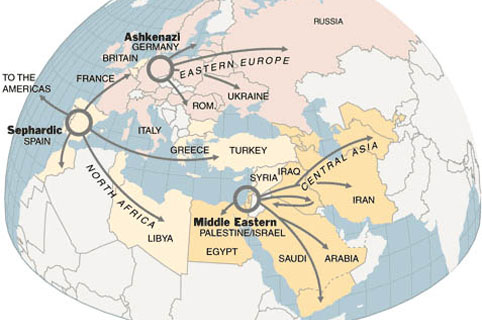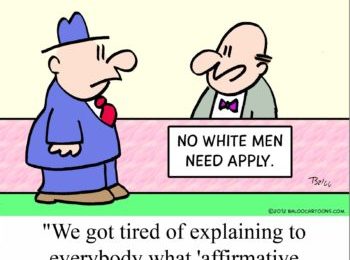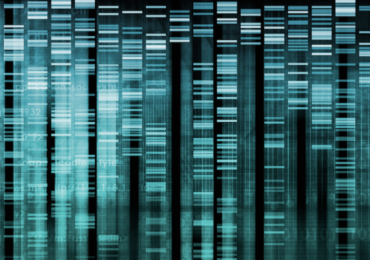 As reported earlier on davidduke.com, it has now been definitively established that Jews are a homogeneous group with all the scientific trappings of what is commonly known as a race, the Israeli Haaretz newspaper has reported.
As reported earlier on davidduke.com, it has now been definitively established that Jews are a homogeneous group with all the scientific trappings of what is commonly known as a race, the Israeli Haaretz newspaper has reported.
In an article titled “DNA links prove Jews are a ‘race,’ says genetics expert,” Haaretz reported that in his new book, “Legacy: A Genetic History of the Jewish People,” Harry Ostrer, a medical geneticist and professor at Albert Einstein College of Medicine in New York, claims that Jews are different, and the differences are not just skin deep.
Jews exhibit, he writes, a distinctive genetic signature.
Geneticists have long been aware that certain diseases, from breast cancer to Tay-Sachs, disproportionately affect Jews. Ostrer, who is also director of genetic and genomic testing at Montefiore Medical Center, goes further, maintaining that Jews are a homogeneous group with all the scientific trappings of what we used to call a “race.”
For most of the 3,000-year history of the Jewish people, the notion of what came to be known as “Jewish exceptionalism” was hardly controversial. Because of our history of inmarriage and cultural isolation, imposed or self-selected, Jews were considered by gentiles (and usually referred to themselves) as a “race.” Scholars from Josephus to Disraeli proudly proclaimed their membership in “the tribe.”
Ostrer explains how this concept took on special meaning in the 20th century, as genetics emerged as a viable scientific enterprise. Jewish distinctiveness might actually be measurable empirically.
Ostrer divides his book into six chapters representing the various aspects of Jewishness: Looking Jewish, Founders, Genealogies, Tribes, Traits and Identity. Each chapter features a prominent scientist or historical figure that dramatically advanced our understanding of Jewishness.
“Legacy” may cause its readers discomfort. To some Jews, the notion of a genetically related people is an embarrassing remnant of early Zionism that came into vogue at the height of the Western obsession with race, in the late 19th century. Celebrating blood ancestry is divisive, they claim: The authors of “The Bell Curve” were vilified 15 years ago for suggesting that genes play a major role in IQ differences among racial groups.
Is Judaism a people or a religion? Or both? The belief that Jews may be psychologically or physically distinct remains a controversial fixture in the gentile and Jewish consciousness, and Ostrer places himself directly in the line of fire.
Yes, he writes, the term “race” carries nefarious associations of inferiority and ranking of people. Anything that marks Jews as essentially different runs the risk of stirring either anti- or philo-Semitism. But that doesn’t mean we can ignore the factual reality of what he calls the “biological basis of Jewishness” and “Jewish genetics.” Acknowledging the distinctiveness of Jews is “fraught with peril,” but we must grapple with the hard evidence of “human differences” if we seek to understand the new age of genetics.
Jews, he notes, are one of the most distinctive population groups in the world because of our history of endogamy. Jews — Ashkenazim in particular — are relatively homogeneous despite the fact that they are spread throughout Europe and have since immigrated to the Americas and back to Israel. The Inquisition shattered Sephardi Jewry, leading to far more incidences of intermarriage and to a less distinctive DNA.
The concept of the “Jewish people” remains controversial. The Law of Return, which establishes the right of Jews to come to Israel, is a central tenet of Zionism and a founding legal principle of the State of Israel. The DNA that tightly links Ashkenazi, Sephardi and Mizrahi, three prominent culturally and geographically distinct Jewish groups, could be used to support Zionist territorial claims — except, as Ostrer points out, some of the same markers can be found in Palestinians.
That disagreement over the meaning of DNA also pits Jewish traditionalists against a particular strain of secular Jewish liberals that has joined with Arabs and many non-Jews to argue for an end to Israel as a Jewish nation. Their hero is Shlomo Sand, an Austrian-born Israeli historian who reignited this complex controversy with the 2008 publication of “The Invention of the Jewish People.”
Sand contends that Zionists who claim an ancestral link to ancient Palestine are manipulating history. But he has taken his thesis from novelist Arthur Koestler’s 1976 book, “The Thirteenth Tribe,” which was part of an attempt by post-World War II Jewish liberals to reconfigure Jews not as a biological group, but as a religious ideology and ethnic identity.
The majority of the Ashkenazi Jewish population, as Koestler, and now Sand, writes, are not the children of Abraham but descendants of pagan Eastern Europeans and Eurasians, concentrated mostly in the ancient Kingdom of Khazaria in what is now Ukraine and Western Russia. The Khazarian nobility converted during the early Middle Ages, when European Jewry was forming.
Although scholars challenged Koestler’s and now Sand’s selective manipulation of the facts — the conversion was almost certainly limited to the tiny ruling class and not to the vast pagan population — the historical record has been just fragmentary enough to titillate determined critics of Israel, who turned both Koestler’s and Sand’s books into roaring best-sellers.
Fortunately, re-creating history now depends not only on pottery shards, flaking manuscripts and faded coins, but on something far less ambiguous: DNA. Ostrer’s book is an impressive counterpoint to the dubious historical methodology of Sand and his admirers. And, as a co-founder of the Jewish HapMap — the study of haplotypes, or blocks of genetic markers, that are common to Jews around the world — he is well positioned to write the definitive response.
In accord with most geneticists, Ostrer firmly rejects the fashionable postmodernist dismissal of the concept of race as genetically naive, opting for a more nuanced perspective.
“About 80% of Jewish males and 50% of Jewish females trace their ancestry back to the Middle East. The rest entered the “Jewish gene pool” through conversion or intermarriage. Those who did intermarry often left the faith in a generation or two, in effect pruning the Jewish genetic tree. But many converts became interwoven into the Jewish genealogical line. Reflect on the iconic convert, the biblical Ruth, who married Boaz and became the great-grandmother of King David. She began as an outsider, but you don’t get much more Jewish than the bloodline of King David!”



